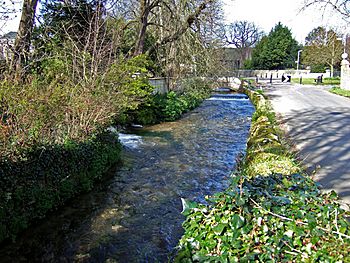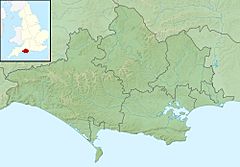River Wey, Dorset facts for kids
Quick facts for kids River Wey |
|
|---|---|

The Wey at Upwey
|
|
|
Location within Dorset
|
|
| Country | England |
| County | Dorset |
| Physical characteristics | |
| Main source | Upwey 50°40′00″N 2°29′00″W / 50.6667°N 2.4833°W |
| River mouth | Weymouth Harbour 50°36′42″N 2°27′27″W / 50.6118°N 2.4576°W |
The River Wey is a chalk stream flowing through Dorset in south west England.
Contents
Course
The river is about 12 kilometres (7.5 mi) long. It rises in Upwey, where the spring forms Upwey Wishing Well, at the foot of the South Dorset Downs, a ridge of chalk hills that separate Weymouth from Dorchester. Most of the course is in the built-up area of Weymouth, running through the former villages (now suburbs) of Upwey, Broadwey, Nottington, and Radipole, through Radipole Lake and into Weymouth Harbour. From source to mouth it falls around 60 metres (200 ft).
History
The river has been important since Roman times, when Radipole Lake was used as a reservoir. The town of Weymouth was established by two harbour villages (Weymouth itself and Melcombe Regis) either side of the mouth. The river was important for milling during the 18th and 19th century, when there were five water mills based along it, all of which who needed to carefully co-ordinate their activities to ensure a reliable flow of water.
The source is an important water supply. There is a large pumping station at Friar Waddon, drawing from the source of the Wey, which is the main water supply for the Isle of Portland. Wessex Water is licensed to pump 14 megalitres of water a day.
Environment
The river is important for wildlife; Radipole Lake is a national nature reserve run by the Royal Society for the Protection of Birds. It has been a Site of Special Scientific Interest since 1979. The spring water of the Wey is used by the Upwey fish farm. The farm also grows watercress, which can normally only be done in good quality water. All water in the farm must be recycled back to the river.
See also
 In Spanish: Río Wey (Dorset) para niños
In Spanish: Río Wey (Dorset) para niños


